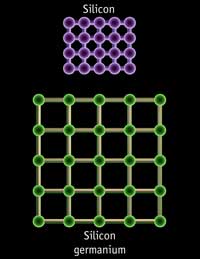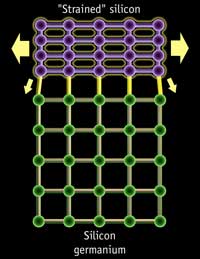Intel's Pentium 4 E: Prescott Arrives with Luggage
by Anand Lal Shimpi & Derek Wilson on February 1, 2004 3:06 PM EST- Posted in
- CPUs
Something to be proud about
Intel is particularly proud of their 90nm process as it incorporates new technologies that are a first in desktop microprocessors. The biggest of them all is the use of Strained Silicon, which we explained back in August of 2002 when Intel first announced that they would use the technology:
Strained Silicon works by effectively stretching the silicon in the channel region of the transistor. The engineers at Intel's fab facilities don't sit there and pull on both ends of the silicon in order to get it to stretch; rather they place the silicon on top of a substrate whose atoms are already spaced further apart than the silicon that needs to be stretched. The result of this is that the silicon atoms on top of the substrate will stretch to match the spacing of the substrate below, thus "stretching" the silicon in the channel.
 |
 |
|
Silicon is "strained" by using a substrate of more widely spaced atoms below the silicon channel of a transistor. (Images courtesy of IBM) |
|
With more well spaced silicon atoms, electrons can now flow with less resistance in the channel meaning that more current can flow through the channel when needed. The end result is a 10 - 20% increase in drive current, or the current flowing through the channel of the transistor.
![]()
Intel claims that their Strained Silicon technology has no real downsides (unlike competing solutions) other than its 2% increase in manufacturing costs. Intel's 90nm process will make use of Strained Silicon technology to improve the performance of their 90nm transistors.
Intel’s 90nm process does not make use of Silicon on Insulator and according to their manufacturing roadmaps it never will. Intel will introduce SOI on their 65nm process in 2005.

Prescott's 112 mm^2 die
Prescott is Intel’s first desktop microprocessor to have 7 metal layers, 2 fewer layers than AMD’s Athlon 64. Intel had to add the 7th layer simply because of the skyrocketing transistor count of Prescott (125 million vs. Northwood’s 55 million). It’s not normally desirable to increase the number of metal layers you have on a chip as it increases manufacturing complexity and cost, but in some cases it is unavoidable. The fact that Intel was able to keep the number of metal layers down to 7 is quite impressive, as AMD had to resort to 9 layers dating back to the introduction of their Thoroughbred-B Athlon XP core to keep clock speeds high.
|
CPU Core Comparison |
|||||
| Code Name |
Willamette |
Northwood |
Northwood EE |
Prescott |
AMD Athlon 64 |
| Manufacturing Process |
0.18-micron |
0.13-micron |
0.13-micron |
90 nm |
0.13-micron |
| Die Size |
217 mm^2 |
131 mm^2 |
237 mm^2 |
112 mm^2 |
193 mm^2 |
| Metal Layers |
6 |
6 |
6 |
7 |
9 |
| Transistor Count |
42 Million |
55 Million |
178 Million |
125 Million |
105.9 Million |
| Voltage |
1.750V |
1.50V |
1.50V |
1.385V |
1.50V |
| Clock Speeds |
1.3 - 2.0GHz |
1.6 - 3.4GHz |
3.2 - 3.4GHz |
2.8 - 4GHz+ |
2.0GHz+ |
| L1 Instruction/Trace Cache | 12K µops |
12K µops |
12K µops |
12K µops |
64KB |
| L1 Data Cache | 8KB |
8KB |
8KB |
16KB |
64KB |
| L2 Cache | 256KB |
512KB |
512KB |
1MB |
1MB |
| L3 Cache | N/A |
N/A |
2MB |
N/A |
N/A |










104 Comments
View All Comments
ianwhthse - Sunday, February 1, 2004 - link
*sigh*Well, now I know.
*goes to buy A64*
KristopherKubicki - Sunday, February 1, 2004 - link
read the article...Stlr22 - Sunday, February 1, 2004 - link
31 stage pipeline?!.....lol..guess those "30 stage pipelne" rumors were true.These processors aren't bad at all. They performed on the same level as the Northwood versions. They just aren't worth the "premium" price tag that they will carry for now.
Looks like there wont be a better time to grab a Northwwod,
as I'm sure these puppies will keep dropping in price to make room for the Prescotts.
Thatguy97 - Wednesday, April 29, 2015 - link
lol never even made to 4ghz man you guys did not give intel the crap it deserved